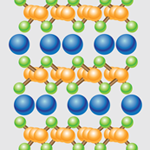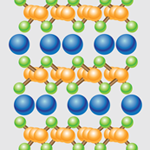Magnetic order is no match for the lattice
Understanding magnetic order in the two major families of iron-based superconductors with layers—namely, electron-doped and hole-doped —is important because magnetism seems to be intimately tied with superconductivity. At about , the undoped compounds ( and = 0) acquire a ferromagnetic stripe ordering along the shorter axis of the square sublattice, while displaying antiferromagnetic ordering along the longer axis and between the layers. Doping with enough carriers suppresses the magnetic order and induces superconductivity in both compounds, though in magnetism and superconductivity coexist for .
Although density-functional calculations overestimate the value of the moment, they generally reproduce the observed magnetic structure for undoped pnictides. In an article appearing in Physical Review B, Alexander Yaresko, Guo-Qiang Liu, Viktor Antonov, and Ole Krogh Andersen at the Max-Planck Institute in Stuttgart, Germany, present comprehensive calculations on experimentally observed crystal structures of and to determine the magnetic behavior as a function of doping. They find that electron doping above in destabilizes the stripe magnetic order and leads to an incommensurate spin spiral order, whereas hole-doping in leaves the magnetic stripe order intact up to . The authors find that in both compounds, the classical Heisenberg model with nearest and next-nearest neighbor spin interactions is inadequate to describe the magnetic order and may require additional terms to accurately compute the energy. – Sarma Kancharla





